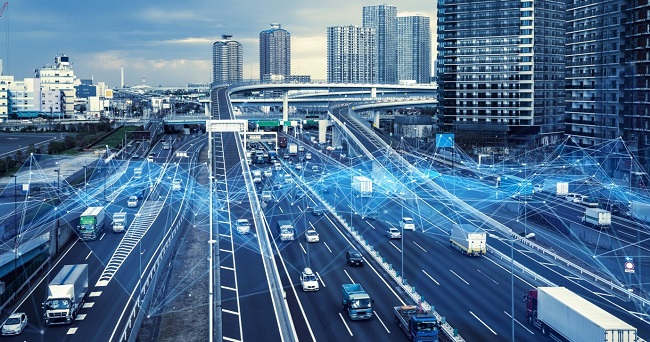Training at Luminator: Protecting smart mobility solutions with IP-design
Smart Mobility: Transforming the Way We Move
Smart mobility is revolutionizing the way people and goods move within cities and across regions. In an era of rapid urbanization, population growth, and environmental concerns, smart mobility solutions are essential to create more efficient, sustainable, and convenient transportation systems. This article explores the concept of smart mobility, its key components, and the transformative impact it has on our daily lives.
 Feedback by Werner Malcharek, Global CTO at Luminator Technology Group, after the training: “Thank you for the inspiring and enlightening training from the IP Business Academy. Before the training, we were not aware of the scale of patent activity on digital and software-based solutions in Europe. For us, patenting the technical implementation of digital objects such as use cases, customer journeys or business models is very relevant. The examples given were powerful and clear in showing the economic importance of digital patents. It is clear that patentability can be achieved through the DIN/ISO-compliant application of the PDCA cycle. The use of patent types for this purpose also became clear. We previously had no knowledge of these topics in-house and will be happy to take advantage of the advice offered on this subject at the beginning of next year.”
Feedback by Werner Malcharek, Global CTO at Luminator Technology Group, after the training: “Thank you for the inspiring and enlightening training from the IP Business Academy. Before the training, we were not aware of the scale of patent activity on digital and software-based solutions in Europe. For us, patenting the technical implementation of digital objects such as use cases, customer journeys or business models is very relevant. The examples given were powerful and clear in showing the economic importance of digital patents. It is clear that patentability can be achieved through the DIN/ISO-compliant application of the PDCA cycle. The use of patent types for this purpose also became clear. We previously had no knowledge of these topics in-house and will be happy to take advantage of the advice offered on this subject at the beginning of next year.”
Defining Smart Mobility
Smart mobility refers to the integration of advanced technologies and data-driven solutions into transportation systems to improve efficiency, accessibility, safety, and sustainability. It encompasses various modes of transportation, including public transit, personal vehicles, bicycles, and pedestrian pathways, all interconnected through digital platforms and smart infrastructure.
Key Components of Smart Mobility
Connected Vehicles: Smart mobility relies heavily on vehicles equipped with advanced communication systems. These connected vehicles can exchange real-time data with each other and with the surrounding infrastructure, enhancing safety and traffic management.
Autonomous Vehicles: Self-driving cars are a significant component of smart mobility. These vehicles use artificial intelligence and sensor technologies to navigate without human intervention, potentially reducing traffic accidents and congestion.
Public Transit Optimization: Smart mobility solutions include the optimization of public transportation networks through real-time tracking, efficient routing, and integrated payment systems. This makes public transit more attractive and accessible to commuters.
Shared Mobility Services: The rise of ridesharing platforms and shared micromobility options like e-scooters and bike-sharing programs promotes more sustainable and cost-effective transportation choices for urban residents.
Data Analytics: Data-driven insights are crucial for smart mobility. Analyzing transportation data can help cities make informed decisions regarding infrastructure development, traffic management, and environmental impact reduction.
Transformative Impact
Reduced Congestion: Smart mobility solutions help alleviate traffic congestion by optimizing traffic flow, reducing accidents, and encouraging shared transportation options. This leads to shorter travel times and decreased frustration for commuters.
Enhanced Safety: Connected and autonomous vehicles can communicate with each other and infrastructure to prevent accidents. This technology has the potential to significantly reduce the number of traffic-related fatalities and injuries.
Environmental Sustainability: Smart mobility promotes environmentally friendly transportation options, such as electric vehicles and public transit. This contributes to lower carbon emissions, improved air quality, and a reduced ecological footprint.
Improved Accessibility: Smart mobility solutions increase transportation accessibility for individuals with disabilities and those living in underserved communities. Real-time tracking and on-demand services make it easier for everyone to get where they need to go.
Economic Benefits: The implementation of smart mobility technologies can stimulate economic growth. It creates jobs in research, development, and maintenance of transportation infrastructure and technology.
Quality of Life: Smart mobility enhances the overall quality of life by reducing stress associated with traffic congestion, providing more time for leisure activities, and fostering a sense of community through shared transportation options.
Challenges
While smart mobility holds immense promise, there are several challenges to overcome. These include concerns about data privacy and security, the high cost of implementing advanced technologies, and the need for robust regulations and policies to ensure safety and fairness.
In conclusion, smart mobility is reshaping the way we move, offering a more efficient, sustainable, and accessible future for transportation. As cities continue to grow and evolve, embracing smart mobility solutions is essential to address the pressing challenges of urbanization, environmental sustainability, and quality of life for residents. By harnessing the power of technology and data, we can create transportation systems that are safer, cleaner, and more convenient for everyone. Smart mobility is not just a vision for the future; it is a reality that is already transforming the way we live and travel.

The Evolution of Digital Services in Public Transport
In recent years, the public transport sector has undergone a significant transformation, driven by the rapid advancement of digital technologies. This evolution has revolutionized the way commuters access, use, and interact with public transportation systems. Here, we explore the key developments in the digital service evolution within public transport.
1 . Mobile Ticketing and Payment: One of the most noticeable changes is the shift from traditional paper tickets to mobile ticketing and payment solutions. Commuters can now purchase tickets, top up travel cards, and pay fares using mobile apps, making the process more convenient and reducing the need for physical tickets.
2 . Real-Time Tracking and Updates: Digital services have introduced real-time tracking of vehicles and schedules. Commuters can check the exact location of buses, trams, or trains and receive updates on delays or changes in service, allowing for better trip planning and reduced wait times.
3 . Trip Planning Apps: Mobile apps and websites offer comprehensive trip planning tools. Commuters can enter their destinations, and these apps provide a range of transportation options, including public transit, rideshares, and walking routes, helping users choose the most efficient and cost-effective ways to get around.
4 . Integration of Multiple Modes: Digital services have facilitated the integration of various modes of transportation, including buses, subways, trams, and bike-sharing systems. Commuters can seamlessly switch between these modes using a single payment system, creating a more interconnected and accessible transit network.
5 . Accessibility Features: Public transport apps now offer accessibility features, making it easier for people with disabilities to use public transportation. These features include information on accessible routes, station facilities, and real-time updates about elevator and escalator status.
6 . Sustainability Initiatives: Many public transport agencies have introduced digital services to support sustainability efforts. These include options for purchasing carbon offsets, accessing information on eco-friendly transportation options, and promoting the use of electric or hybrid vehicles within their fleets.
7 . Data-Driven Insights: The collection and analysis of data generated by digital services allow public transport agencies to optimize routes, schedules, and infrastructure. This leads to more efficient services and better resource allocation.
The evolution of digital services in public transport has not only improved the commuter experience but also helped public transport systems operate more efficiently, reduce environmental impact, and enhance accessibility. As technology continues to advance, we can expect further innovations in public transportation, ultimately leading to more sustainable, accessible, and convenient urban mobility solutions.
Luminator – Intelligence, Safety and Efficiency in transit
Luminator Technology Group delivers globally-recognized technology solutions that increase intelligence, safety, and efficiency for public transit operations. Luminator was established and is purposefully architected to make a lasting impact on the transit technology market. Combining strategic research and development with smart acquisitions, they are merging a broad range of expertise and new technology along with best-in-class products from successful, well-known regional companies into one cohesive, global organization.
Luminator is uniquely positioned to provide solutions to connect transit passengers to vital information while supporting the operational objectives of efficient transit operations. Supporting transit bus and rail car manufacturers as well as public transit operators around the globe, Luminator is developing and delivering technology with tangible benefits to public transit.
Are you ready to expand your knowledge and become a university certified professional?
Read more about our “Integrated IP and Innovation Management” course HERE and have a sneak peek into the certified university course on a digital parking experience. How to protect such digital solutions for smart mobility with IP-design was also the topic of a training by Prof. Alexander Wurzer at Luminator on 8.8.2023.



